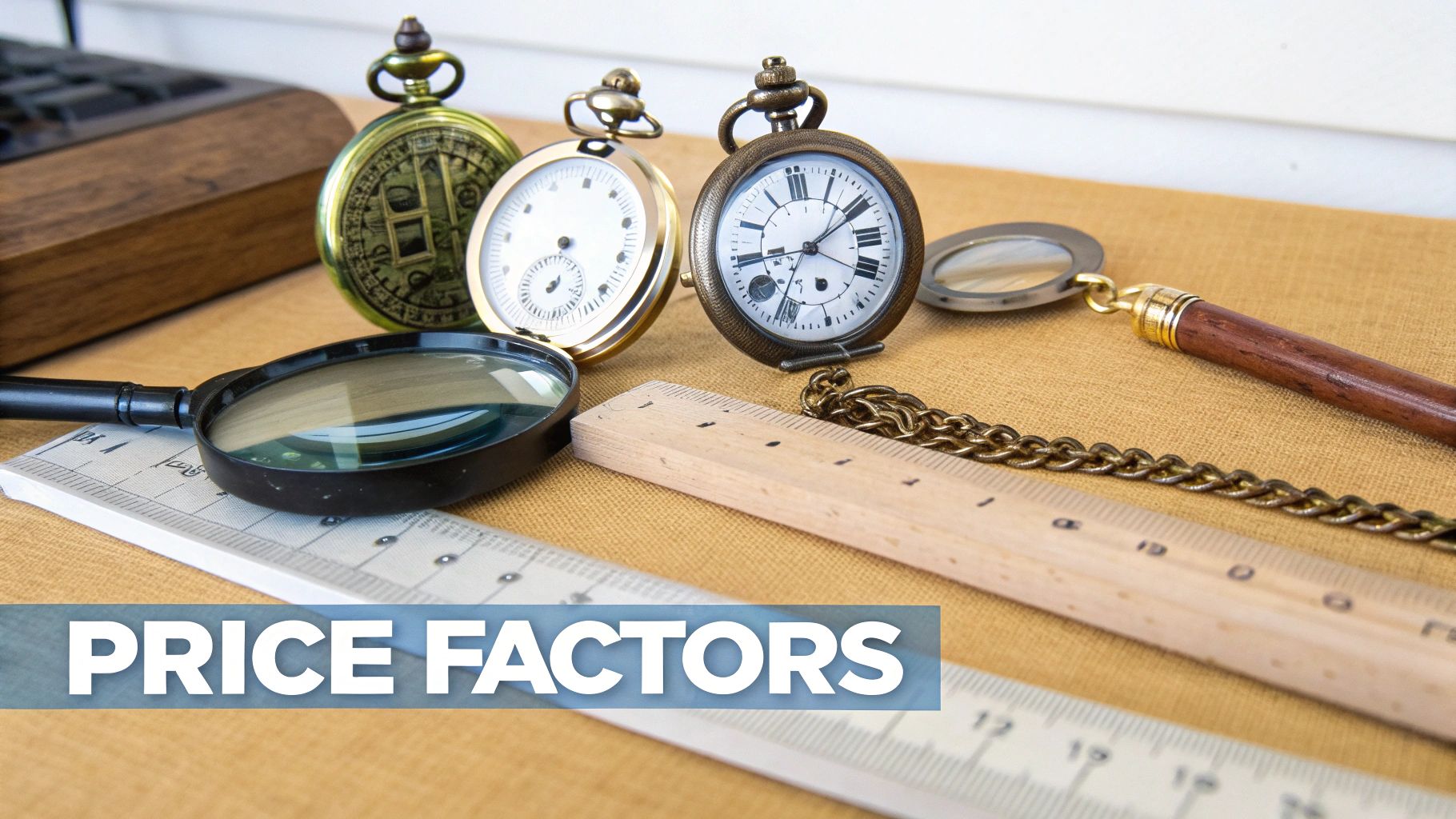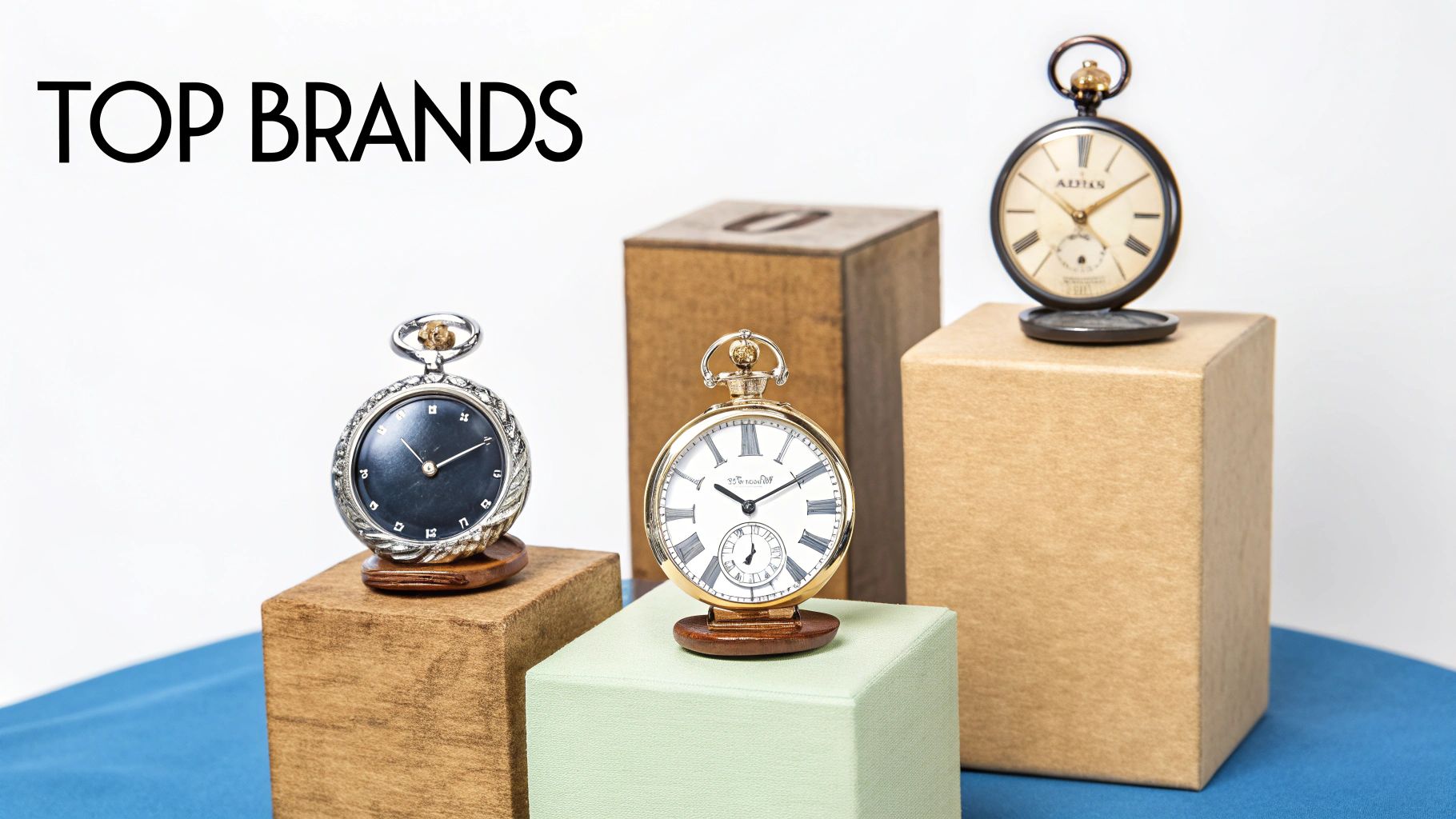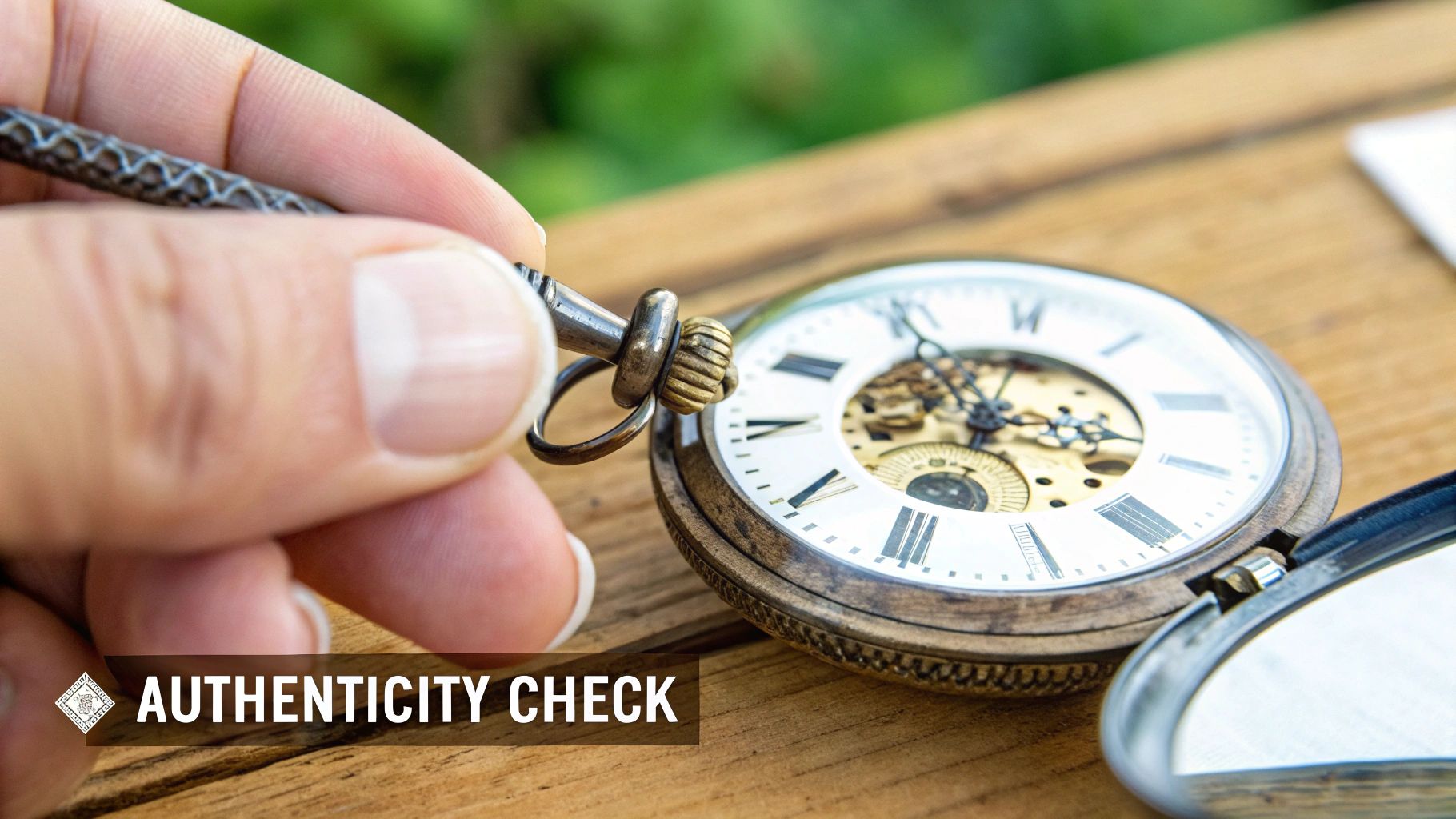Let's cut right to the chase: antique pocket watch prices can range from less than $100 for a common, everyday model to well over a million dollars for the rarest masterpieces. It’s a lot like valuing a classic car—a mass-produced Ford Model T and a one-of-a-kind Bugatti are both technically "antique cars," but they exist in completely different worlds when it comes to value.
How to Figure Out Your Pocket Watch's Value
Figuring out what an antique pocket watch is worth means looking at a lot more than just its age or how shiny the case is. It’s like a complex recipe where several key ingredients have to come together just right to create the final price tag.
The market for these old timepieces is huge. In fact, the global pre-owned luxury watch market was valued at an incredible USD 24.38 billion in 2023. This intense demand is what can send prices into the stratosphere, like when a Patek Philippe pocket watch fetched a mind-boggling $24 million at auction.
The Five Core Value Factors
So, where do you start? Appraisers and serious collectors almost always begin by looking at five fundamental pillars. Each one plays a crucial role in the final valuation, and understanding them is the first step toward knowing what you've got.
- The Maker: Who actually made the watch? A name like Patek Philippe, Vacheron Constantin, or Audemars Piguet carries a ton of weight and instantly puts a watch in a higher category than a lesser-known or mass-market brand.
- The Movement: This is the "engine" of the watch. How complex is it? Movements with a high jewel count and special features (known as "complications") like chronographs, perpetual calendars, or minute repeaters are far more valuable.
- The Case: What is the watch's outer shell made of? A solid 18k gold or platinum case is obviously worth more than a gold-plated or silver one. Intricate engravings, enamel work, or embedded jewels can also add tremendous value.
- The Rarity: How many of these are out there? A watch from a limited production run, a prototype, or one with a unique history (like being owned by someone famous) is highly desirable to collectors.
- The Condition: Is the watch original and well-preserved? A pristine, all-original timepiece will always command a premium. Scratches, dents, a cracked dial, or non-original replacement parts will significantly lower the value.
To make this a bit easier to digest, here’s a quick summary of the key factors that drive an antique pocket watch's price.
Key Factors Influencing Antique Pocket Watch Prices
| Factor | Description | Impact on Price |
|---|---|---|
| Maker | The reputation and prestige of the watch manufacturer. | High: Well-known luxury brands like Patek Philippe dramatically increase value. |
| Movement | The internal mechanics, including jewel count and complexity. | High: Complications like chronographs or minute repeaters add significant value. |
| Case | The material and craftsmanship of the watch's outer shell. | High: Solid gold, platinum, and elaborate enamel or engraving command top dollar. |
| Rarity | The scarcity of the model, based on production numbers or history. | Very High: Limited editions or watches with unique provenance are most sought-after. |
| Condition | The physical state of the watch, including originality of parts. | Very High: Pristine, all-original condition is crucial for achieving peak value. |
Looking at these five areas gives you a solid framework for building a clear picture of where your watch stands in the market.
Ultimately, valuing an antique is all about finding what a willing buyer would pay for it today. This is often called its Fair Market Value. When thinking about this, it helps to approach it from a financial perspective, not unlike understanding profit margins in a business. You can dive deeper into this concept in our guide on what is fair market value.
The Five Pillars of Pocket Watch Value

Trying to figure out what an antique pocket watch is worth feels a lot like sizing up a classic car. You don't just glance at the shiny paint; you pop the hood, check the engine, see who made it, and look for signs of wear and tear. It's the same deal with watches. Their value boils down to five core elements, and each one plays a huge role in the final price tag.
Pillar 1: The Maker
First things first, whose name is on the watch? The maker's reputation is often the biggest piece of the puzzle. Think of it like this: a Patek Philippe is the Rolls-Royce of the watch world. They were famous for incredible craftsmanship, tiny production numbers, and a history of pure luxury. Because of that, even a basic Patek pocket watch can easily fetch tens of thousands of dollars.
On the other hand, a maker like the American Waltham Watch Company is more like a classic Ford. They were workhorses, producing millions of reliable, well-made watches that everyday people could own and cherish. While a common Waltham might only be worth a few hundred bucks, a rare, high-grade model can still be a serious collector's item. The maker really sets the stage for a watch's potential value.
Pillar 2: Movement and Jewels
The movement is the mechanical heart of the watch. Its complexity is a direct reflection of the skill that went into making it. A simple movement that just tells time is one thing, but the really valuable pieces have "complications"—extra features that add a ton of value. We're talking about things like chronographs (stopwatches), minute repeaters (which chime the time), or perpetual calendars.
Jewels are a key part of that complexity. These tiny synthetic rubies act as bearings for the gears, cutting down on friction and wear, which makes the watch more accurate and durable.
- 7-15 Jewels: This was standard for a good quality watch of its time.
- 17-21 Jewels: You're looking at a high-grade movement here, often found in super-accurate railroad watches.
- 23+ Jewels: This is top-of-the-line, the peak of watchmaking artistry for that era.
Generally speaking, a higher jewel count points to a better-made, more valuable movement. It’s a detail that directly moves the needle on price.
A watch's movement is its soul. A beautifully complicated movement from a top-tier maker is what separates a simple antique from a true horological masterpiece that collectors will pay a premium to own.
Pillar 3: Case Material
If the movement is the engine, the case is the bodywork. What it’s made of has a very direct impact on value. It’s simple, really: a solid gold case will always be worth more than a gold-filled or silver one, if only for its raw melt value.
Here’s a quick rundown of the most common case materials, from most to least valuable:
- Platinum or High-Karat Gold (18k-24k): The absolute top shelf. These are the most desirable and valuable cases you can find.
- Lower-Karat Gold (10k-14k): Very common in American pocket watches and still highly valuable.
- Solid Silver: A popular choice, especially for older European watches, and it holds its value well.
- Gold-Filled or Rolled Gold Plate: This is a base metal with a thin layer of gold bonded to it. It’s less valuable but makes for a handsome and collectible watch.
- Base Metal (Nickel, Brass): These were the cheapest to produce and are the least valuable today, typically used for no-frills, utilitarian watches.
Of course, fancy engravings, detailed enamel work, or diamonds set into the case can send the price soaring, sometimes adding thousands all on their own.
Pillar 4: Rarity
This one is simple economics: how many were made? Scarcity is a huge driver in any collectible market. A watch that was part of a limited run of just 50 pieces is naturally going to be more sought-after than a model with 50,000 floating around.
Rarity can also come from a watch's story. Maybe it was a prototype, one of the very first of its kind. Or perhaps it was presented to a famous historical figure. These unique circumstances can turn an otherwise ordinary watch into a legendary find for collectors. Digging into a watch's history can sometimes uncover a hidden gem worth far more than its parts.
Pillar 5: Condition and Originality
Finally, how well has the watch survived the years? A pristine watch that looks like it just left the factory—what collectors call "new old stock"—is the holy grail. Everything, from the hands and dial right down to the tiny screws inside the movement, should be original.
Here’s what eagle-eyed collectors are looking for:
- A clean dial with no cracks or hairline fractures.
- A case that hasn't been polished to death, with its original sharp lines intact.
- The original hands and crystal.
- A movement that’s clean, free of rust, and shows no signs of sloppy repairs.
Any replacement parts, a badly damaged dial, or a seriously dented case will cause the value to plummet. Originality is everything. A well-preserved, all-original piece will always bring top dollar.
Why a Watch's History Matters

An antique pocket watch isn't just a way to tell time; it's a miniature time capsule. The story behind a watch—who made it, when, and for what purpose—directly shapes its value. When you understand its history, you stop seeing it as just a mechanical object and start seeing it as a piece of the past that collectors truly treasure. This story is often why pocket watch prices antique collectors are willing to pay what they do.
Every era in watchmaking had its own distinct styles, technologies, and motivations. The earliest watches from the 16th and 17th centuries, for instance, are the stuff of legend.
These weren't tools; they were breathtaking status symbols, handcrafted for European royalty and aristocrats. Finding one today is like unearthing a lost treasure. It's no surprise, then, that an early German "Tambour" watch from the 1500s can fetch anywhere from £15,000 to £25,000, simply because of its incredible age and rarity. If you're curious, you can explore more about pocket watch history and value on antique-watch.com.
The Shift from Luxury to Precision
Moving into the 18th and early 19th centuries, watches were still very much luxury goods, but the focus sharpened on exquisite, refined craftsmanship. This was the age of handmade elegance, where master watchmakers created ornate, detailed pieces for the wealthy elite, all before machines took over.
Then came the Industrial Revolution, and it changed everything. The late 19th and early 20th centuries marked the golden age for American and Swiss watchmaking. Mass production didn't cheapen the product; it actually ushered in an era of unprecedented reliability and accuracy.
This era gave us the legendary "railroad-grade" pocket watch. These weren't just for show. They were built to incredibly strict standards to keep the trains running on time and prevent collisions, making them monuments to precision engineering. Their historical job and robust build make them highly sought-after today.
This period put a high-quality timepiece within reach of the growing middle class for the first time. For these watches, value is tied to the maker's reputation (think Elgin, Waltham, or Hamilton), the precision of the movement, and their connection to a hugely important moment in history. Understanding this context is central to appreciating a watch's true worth and what is historical significance in the antiques world.
Tracking Today's Collector Market

To really get a handle on what collectors are paying for antique pocket watches, you need to do more than just read up on a watch’s history. You have to get a feel for the market's current pulse. An antique timepiece’s value isn’t some static number printed in a price guide; it’s a living, breathing figure that ebbs and flows with collector tastes, economic shifts, and even new historical discoveries.
Think of it as a stock market for tiny, intricate machines. One year, ornately engraved European watches might be the hot ticket. The next, everyone could be chasing the rugged simplicity of American railroad watches. These shifts are often sparked by new research, the influence of a major collector, or sometimes even a mention in pop culture.
A great example of this is the boom in American railroad watches. Their incredible precision and direct connection to a vital chapter of industrial history have made them hugely popular. As more people learn their story, demand climbs, and prices follow suit.
How to Monitor Market Trends
So, how do you stay on top of it all? You don’t need to be an industry insider. The trick is simply knowing where to look for real-world sales data and what collectors are talking about. This is how you get a true sense of what buyers are actually paying right now.
Here are a few of the best places to start:
- Online Auction Results: A site like eBay is an absolute goldmine. Don't just look at what's for sale—search for your specific watch model under the "sold items" filter. That tells you what people have genuinely paid for it recently.
- Collector Forums: Online communities built around horology are invaluable. This is where enthusiasts discuss recent auction prices, share new finds, and debate the finer points of different models. It's the digital version of the old watchmakers' guild.
- Specialized Databases: For a more organized approach, websites that compile auction results and production data can help you track a watch’s value over a longer period.
By checking in on these resources regularly, you'll start to see the patterns emerge. You’ll notice which brands consistently command top dollar and which sleeper models are suddenly waking up.
The antique watch market is incredibly dynamic. Even common, everyday models can see surprising shifts in value. Staying informed is the single best way to understand where your watch fits into the collector world, whether you’re looking to buy, sell, or just appreciate what you own.
Recent numbers show just how much things can change. Take the common Waltham "Appleton, Tracy & Co." model from 1877. Its average value jumped by a surprising 22.6%, with examples now selling for around $195. The Elgin 349 model saw a similar bump of 15.3%, bringing its average value up to $233. You can dig deeper into these pocket watch value trends and what's driving them to see just how active the market is.
How to Investigate Your Own Pocket Watch
Ready to do a little detective work? Digging into your own timepiece is the first and most exciting step toward understanding its story and, of course, what it might be worth. With a bit of careful observation, you can uncover the key clues that reveal where your watch came from, when it was made, and what it’s made of. This initial research is critical to figuring out the kind of pocket watch prices antique collectors are looking for.
The most important information isn't on the outside—it's tucked away inside. You'll need to safely open the case back to find it. Most antique pocket watch cases have a small lip along the edge you can gently pry open with a dull case knife or even a strong fingernail. Others are screw-off backs that simply twist open. Once inside, you'll see the watch's mechanical heart: the movement.
Finding the Serial Number
The serial number is the golden ticket. It's usually engraved right on the movement itself, not on the inside of the case. This number is your key to unlocking the watch's entire history.
Once you have that number, online resources are your best friend. For American-made watches from giants like Elgin, Waltham, and Hamilton, the Pocket Watch Database is an absolutely essential tool.

Just enter the maker and serial number, and the database will instantly spit out a treasure trove of information. You'll likely see the estimated production year, the jewel count, the specific model, and more. This gives you a fantastic snapshot of your watch’s origins.
Before you go looking for a formal appraisal, it's a great idea to gather all the information you can on your own. This not only helps you understand your watch better but also gives a professional a solid starting point. Here's a quick checklist to guide you.
DIY Pocket Watch Investigation Checklist
| Step | Action to Take | What to Look For |
|---|---|---|
| 1. Open the Case | Carefully open the back of the watch case to expose the movement. | A small lip for prying or a screw-off design. Be gentle! |
| 2. Find the Serial Number | Look for a number engraved directly on the metal plates of the movement. | Write it down exactly as you see it, along with the manufacturer's name. |
| 3. Research Online | Use a resource like the Pocket Watch Database for American watches. | Production date, jewel count, grade, and model information. |
| 4. Check the Dial | Examine the watch face closely under good light. | Hairline cracks, chips (especially around the edges), or discoloration. |
| 5. Inspect the Case | Look for markings, dents, and heavy scratches. | Stamps like "14k" or "18k" for solid gold, or "Gold-Filled" for plated. |
| 6. Assess the Crystal | Check the glass or plastic cover over the dial. | Deep scratches, cracks, or chips that might need replacing. |
| 7. Test Functionality | Give the watch a gentle wind. | Does it start ticking? Does it seem to keep time for at least a few minutes? |
This little bit of homework will put you miles ahead when you decide to take the next step.
Performing a Basic Condition Check
Now it's time for a closer look. You don’t need to be a seasoned horologist to spot the basics, and a thorough visual check will give you a realistic sense of its condition—a massive factor in its final value.
- Dial: Look for tiny hairline cracks in the enamel, chips, or any staining. A clean, flawless dial is always what collectors want to see.
- Case: Are there deep dents or heavy scratches? Is the engraving worn smooth? Note any markings indicating solid gold (like 14k) versus gold-filled.
- Crystal: Are there any ugly scratches or cracks on the glass? These can often be replaced, but it's a condition issue.
- Functionality: If you give it a gentle wind, does it tick? Even better, does it seem to keep time for a few minutes?
Knowing the case material is also a huge piece of the puzzle. If you see gold markings, you might want to look into methods to test gold purity to understand its potential value better.
When to Call a Professional
Your own investigation gives you a fantastic starting point, but it isn't the final word. If your research suggests you have something special—a watch from a top-tier maker, one with a high jewel count, or a solid gold case—it’s time to talk to a pro.
A professional appraiser can do things you can't, like verifying authenticity, assessing the internal condition of the movement, and providing a valuation based on real-time market data. This is an absolute must for insurance or if you're thinking about selling.
A formal appraisal is what connects your detective work to a certified, market-ready valuation. To get ready for that final step, have a look at our detailed guide on https://www.curio.app/blog/how-to-appraise-antiques. It will walk you through what to expect and how to find an expert you can trust.
Common Questions About Pocket Watch Value
As you dive into the world of antique pocket watches, you'll find a few questions pop up time and time again. Maybe you've inherited a family heirloom or stumbled upon a tarnished treasure at an estate sale. Getting clear answers to these common questions is the first step toward making a smart decision.
Let's cut through the noise and tackle the most frequent questions people have. Understanding these nuances is key to figuring out the real pocket watch prices antique collectors are willing to pay.
Does a Non-Working Pocket Watch Have Any Value?
Yes, absolutely! This is probably the biggest misconception out there. While a watch that runs perfectly will almost always fetch a higher price, a non-working antique can still be incredibly valuable.
Think of it this way: the watch's story isn't just about telling time. Its value is wrapped up in its history, materials, and artistry.
- Case Material: Is the case made of solid gold or platinum? Its value as a precious metal is still there, ticking or not. That intrinsic worth provides a solid price floor.
- Brand and Rarity: A rare model from a legendary maker like Patek Philippe or Vacheron Constantin is still a prize, even if it needs work. Serious collectors often see a professional repair as a worthy investment to bring a masterpiece back to life.
- Parts Value: To a watchmaker, a broken antique can be a goldmine. It’s a source of original, hard-to-find parts needed to restore other historical timepieces.
So, never write off a watch just because it’s stopped. Its name, materials, and rarity are often the real drivers of its value.
Is an Engraved Pocket Watch Worth More or Less?
This is the classic "it depends" situation. An engraving can send a watch's value soaring or sink it, and the deciding factor is always the story behind it.
A simple, generic monogram—like a stranger's initials—usually lowers the value for most buyers. People often want a clean slate they can make their own. However, if that engraving tells a compelling story, everything changes.
An engraving that ties the watch to a famous person, a historical event, or a respected institution (like a railroad presentation watch for exemplary service) can make its value skyrocket. The inscription provides provenance—a documented history—that elevates the watch from a simple antique to a tangible piece of history. The story becomes its most valuable asset.
How Do I Find a Reputable Watch Appraiser?
Finding an expert you trust is non-negotiable for getting an accurate valuation. You need a specialist in horology (the study of timekeeping) who lives and breathes antique pocket watches, not just a general jeweler.
Start your search by looking for appraisers with credentials from well-known organizations. The National Association of Watch and Clock Collectors (NAWCC) is an excellent starting point.
High-end jewelry stores that handle estate pieces or dedicated antique watch dealers are also great resources. Before you commit, always ask about their specific experience with watches from your piece's era.
Where Is the Best Place to Sell an Antique Pocket Watch?
The right place to sell really depends on the watch you have. For the truly exceptional, high-value timepieces, a major auction house like Christie's or Sotheby's is your best bet. They connect you with a global network of serious collectors ready to compete for rare items.
For more common or mid-range watches, you've got several solid options. Online marketplaces like eBay can expose your watch to a huge audience, but you'll need to create a detailed listing with fantastic photos. Collector forums often have "for sale" sections where you can connect directly with enthusiasts who know what they're looking at.
Finally, selling to a trusted local antique watch dealer is often the quickest and easiest path. You might get a bit less than you would at auction, but you get a fast, simple transaction in return.
Uncovering the history and value of your antique pocket watch is a rewarding journey. What begins as simple curiosity can quickly grow into a deep appreciation for the incredible craftsmanship of the past. If you're ready for instant answers, Curio puts an antique expert right in your pocket. Just snap a photo to identify, appraise, and learn the story behind your treasures.
